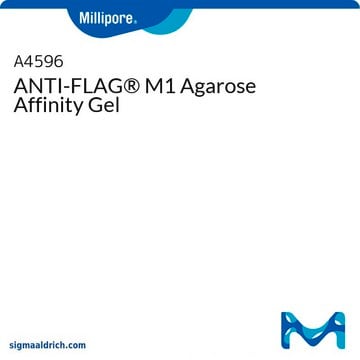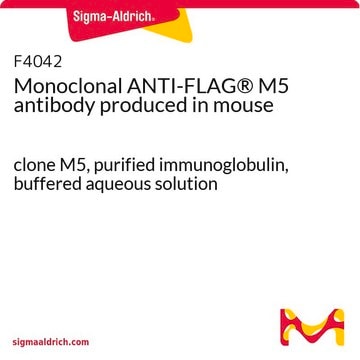F3040
Monoclonal ANTI-FLAG® M1 antibody produced in mouse
clone M1, purified immunoglobulin, buffered aqueous solution
Sinónimos:
Anti-ddddk, Anti-dykddddk
About This Item
Productos recomendados
biological source
mouse
conjugate
unconjugated
antibody form
purified immunoglobulin
antibody product type
primary antibodies
clone
M1, monoclonal
form
buffered aqueous solution
purified by
using Protein A
species reactivity
all
concentration
2-5 mg/mL
technique(s)
western blot: 10 μg/mL
immunogen sequence
DYKDDDDK
shipped in
dry ice
storage temp.
−20°C
Categorías relacionadas
General description
Method of purification - Protein A
Immunogen
Application
Applications in which this antibody has been used successfully, and the associated peer-reviewed papers, are given below.
Chromatin immunoprecipitation (1 paper)
Immunofluorescence (1 paper)
Learn more product details in our FLAG® applications portal.
Biochem/physiol Actions
Physical form
Preparation Note
Legal Information
Not finding the right product?
Try our Herramienta de selección de productos.
Storage Class
10 - Combustible liquids
wgk_germany
WGK 1
flash_point_f
Not applicable
flash_point_c
Not applicable
Certificados de análisis (COA)
Busque Certificados de análisis (COA) introduciendo el número de lote del producto. Los números de lote se encuentran en la etiqueta del producto después de las palabras «Lot» o «Batch»
¿Ya tiene este producto?
Encuentre la documentación para los productos que ha comprado recientemente en la Biblioteca de documentos.
Los clientes también vieron
Nuestro equipo de científicos tiene experiencia en todas las áreas de investigación: Ciencias de la vida, Ciencia de los materiales, Síntesis química, Cromatografía, Analítica y muchas otras.
Póngase en contacto con el Servicio técnico













